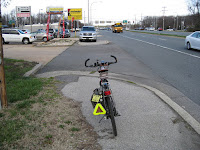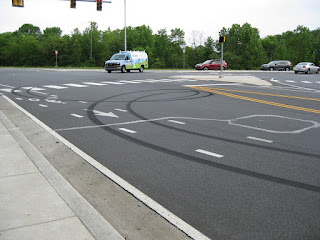 |
| Seriously eroded ECG used for car parking |
With the approval of a Historical Marker commemorating Ogletown, and a quarter millennia since the passing of its founder, the time has come to improve multi-modal access to this historic site. Regional legislators, including Senator Jack Walsh, have already agreed on action to address the failed infrastructure surrounding Thomas Ogle's tomb and green space. This includes the East Coast Greenway (ECG) west from SR273, and two connectors: one to Prides Crossing and the other to Chestnut Hill Estates via Old Ogletown Rd.
More recently, we discovered the gross lack of zebra striping of the ECG (streetview) through Chestnut Hill Plaza, a Meineke repair shop, and a Liberty gas station. Meinekie has even adopted the ROW as defacto car parking. This facility was originally paved at the width (8') required for bidirectional bike-ped traffic, and is eroded and narrowing in many sections. It rises up and back down through driveways, when the opposite is required for traffic calming and multi-modal awareness. Adding zebra crossings won't fix the problem of high speed entrances from SR4, but will bring awareness (and thus some added safety) for ECG users and Ogletown destination-making.
 |
| ECG just west of Augusta Drive |
The long range goal for the ECG is a continuous facility brought up to modern design standards, some of which can be found further to the east. Recent setbacks like Augusta, however, only cement Ogletown among the disenfranchised. When asked, there are few to no answers from several oversight orgs. In contrast, Advocates should be pouncing on each and every opportunity to improve the ECG -- even with basic highway maintenance projects as called for in DelDOT's Complete Streets policy.
This proposal to enhance placemaking in Ogletown would bring some consolation -- not just for Thomas Ogle but also the loss of the Orphanage Property as a regional park -- the chance of which will never come again.













